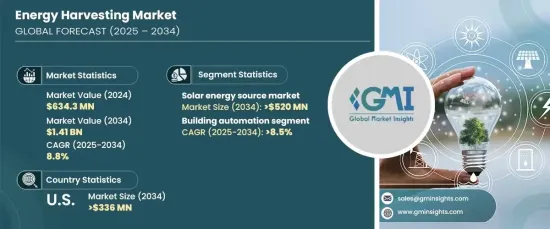
세계 에너지 수확 시장은 2024년 6억 3,430만 달러에 달했고, 2025-2034년 연평균 8.8%의 견조한 성장세를 보일 것으로 예측됩니다. 이러한 성장은 환경 문제, 에너지 비용 상승, 재생 가능 기술의 발전 등을 배경으로 전 세계가 지속가능한 에너지 솔루션으로 전환하고 있음을 뒷받침합니다. 에너지 수확 기술은 특히 IoT 센서, 웨어러블 기술, 원격 모니터링 시스템과 같은 저에너지 장치에 전력을 공급하기 위해 기존 에너지 원에 대한 비용 효율적이고 효율적인 대안을 제공하기 때문에 빠르게 각광을 받고 있습니다.

스마트 기기의 채택이 확대되고 다양한 분야에서 무정전 전원 솔루션의 필요성이 증가함에 따라 에너지 수확 시스템에 대한 수요는 더욱 급증할 것으로 예상됩니다. 이러한 기술은 기존의 그리드 기반 에너지 의존도를 낮추는 데 매우 중요하며, 업무의 지속가능성과 에너지 효율을 향상시키려는 산업계의 핵심 요소입니다. 기업과 소비자가 환경 및 에너지 목표를 달성하기 위해 노력하는 가운데, 시장은 혁신적으로 성장하고 있습니다.
| 시장 범위 | |
|---|---|
| 시작 연도 | 2024년 |
| 예측 연도 | 2025-2034년 |
| 시작 금액 | 6억 3,430만 달러 |
| 예상 금액 | 14억 1,000만 달러 |
| CAGR | 8.8% |
태양광 에너지 분야는 태양광 패널 및 관련 부품의 비용 하락으로 2034년까지 5억 2,000만 달러 규모에 달할 것으로 예상됩니다. 전 세계 기업들은 지속가능성 목표에 부합하는 비용 효율적이고 환경 친화적인 솔루션으로 태양에너지를 주목하고 있습니다. 첨단 에너지 저장 시스템의 통합은 태양광 발전의 간헐성을 완화하고 보다 안정적이고 안정적인 에너지 공급을 보장합니다. 정부의 우대 정책, 세금 환급, 태양광 발전 기술의 끊임없는 발전은 태양광 발전의 보급을 더욱 촉진하고 세계 에너지 소비 패턴의 재구축에 있어 태양광 발전의 역할을 확고히 하고 있습니다.
빌딩 자동화는 에너지 수확 시장에서 괄목할 만한 성장세를 보이고 있으며, 예측 기간 동안 8.5%의 연평균 복합 성장률(CAGR)을 보일 것으로 예상됩니다. 에너지 수확은 보다 스마트하고 에너지 효율적인 건물의 개발을 가능하게 하고 있습니다. 기술 혁신은 에너지 수확 시스템을 건축 인프라에 통합하고 원격 모니터링 및 제어를 지원하는 에너지 수확 시스템의 통합을 강화하고 있습니다. 이러한 솔루션은 대규모의 복잡한 건물의 에너지 관리를 최적화하고 운영 비용을 절감하며 지속가능성 목표를 달성하는 데 중요한 역할을 하고 있습니다. 지능형 빌딩 설계에 대한 관심이 높아짐에 따라 에너지 수확 기술의 채택이 가속화되고 있으며, 이 부문이 확대되고 있습니다.
미국의 에너지 수확 시장은 2034년까지 3억 3,600만 달러에 달할 것으로 예상되며, 이는 재생 가능 에너지와 지속 가능한 건설 관행에 대한 국가적 노력에 힘입어 성장하고 있습니다. 세금 공제 및 리베이트를 제공하는 연방, 주 및 지역 프로그램은 태양광 및 풍력과 같은 재생 가능 에너지 기술에 대한 투자를 촉진하고 있습니다. 이러한 혜택은 환경적 책임에 대한 관심 증가와 함께 에너지 수확 솔루션에 대한 수요를 촉진하고 미국을 세계 시장의 선두주자로 자리매김하고 있습니다. 에너지 수확 기술은 보급이 확대됨에 따라 국가 재생 가능 에너지 전략에서 중요한 요소로 자리 잡고 있습니다.
The Global Energy Harvesting Market reached USD 634.3 million in 2024 and is forecasted to grow at a robust CAGR of 8.8% from 2025 to 2034. This growth underscores the increasing global shift toward sustainable energy solutions driven by environmental concerns, rising energy costs, and advancements in renewable technologies. Energy harvesting technologies are rapidly gaining prominence as they offer cost-effective and efficient alternatives to traditional energy sources, particularly for powering low-energy devices such as IoT sensors, wearable technologies, and remote monitoring systems.

With the expanding adoption of smart devices and the rising need for uninterrupted power solutions in various sectors, the demand for energy harvesting systems is expected to surge further. These technologies are pivotal in reducing dependency on conventional grid-based energy, making them a cornerstone for industries aiming to enhance operational sustainability and energy efficiency. As businesses and consumers strive to meet environmental and energy goals, the market is set for transformative growth.
| Market Scope | |
|---|---|
| Start Year | 2024 |
| Forecast Year | 2025-2034 |
| Start Value | $634.3 Million |
| Forecast Value | $1.41 Billion |
| CAGR | 8.8% |
The solar energy segment is projected to reach USD 520 million by 2034, driven by the declining costs of solar panels and associated components. Businesses across the globe are turning to solar energy as a cost-efficient and eco-friendly solution, aligning with their sustainability objectives. The integration of advanced energy storage systems is mitigating the intermittency of solar power, ensuring a more reliable and consistent energy supply. Favorable government incentives, tax rebates, and continuous advancements in solar technology further encourage widespread adoption, solidifying solar energy's role in reshaping global energy consumption patterns.
Building automation is poised for significant growth within the energy harvesting market, with an expected CAGR of 8.5% during the forecast period. Energy harvesting is enabling the development of smarter, more energy-efficient buildings. Innovations in technology are enhancing the integration of energy harvesting systems into building infrastructure, supporting remote monitoring and control. These solutions play a critical role in optimizing energy management in large, complex structures, reducing operational costs, and meeting sustainability targets. The growing emphasis on intelligent building design is accelerating the adoption of energy harvesting technologies, propelling segment expansion.
The U.S. energy harvesting market is forecasted to reach USD 336 million by 2034, fueled by the nation's commitment to renewable energy and sustainable construction practices. Federal, state, and local programs offering tax credits and rebates are spurring investments in renewable energy technologies like solar and wind. These incentives, combined with an increased focus on environmental responsibility, are driving demand for energy harvesting solutions, establishing the U.S. as a leader in the global market. As adoption continues to grow, energy harvesting technologies are becoming a key element in the nation's renewable energy strategy.